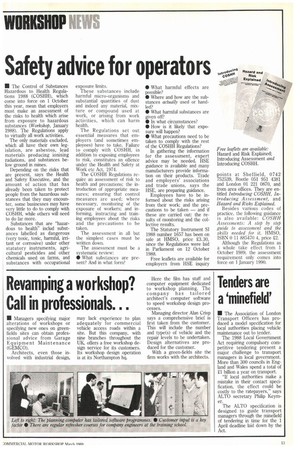Safety advice for operators
Page 119

If you've noticed an error in this article please click here to report it so we can fix it.
• The Control of Substances Hazardous to Health Regulations 1988 (COSHH), which come into force on 1 October this year, mean that employers must make an assessment of the risks to health which arise from exposure to hazardous substances (Workshop, January 1988). The Regulations apply to virtually all work activities.
The only materials excluded, which all have their own legislation, are asbestos, lead materials producing ionising radiations, and substances below ground in mines.
Depending on the risks that are present, says the Health and Safety Executive, and the amount of action that has already been taken to protect people from the hazardous substances that they may encounter, some businesses may have very little to do to comply with COSHH, while others will need to do far more.
Substances that are "hazardous to health" includ substances labelled as dangerous (very toxic, toxic, harmful, irritant or corrosive) under other statutory instruments, agricultural pesticides and other chemicals used on farms, and substances with occupational exposure limits.
These substances include harmful micro-organisms and substantial quantities of dust and indeed any material, mixture or compound used at work, or arising from work activities, which can harm health.
The Regulations set out essential measures that employers (and sometimes employees) have to take, Failure to comply with COSHH, in addition to exposing employees to risk, constitutes an offence under the Health and Safety at Work etc Act, 1974.
The COSHH Regulations require an assessment of risk to health and precautions; the introduction of appropriate measures; ensuring that control measures are used; where necessary, monitoring of the exposure of workers; and informing, instructing and training employees about the risks and the precautions to be taken.
The assessment in all but the simplest cases must be written down.
The assessment must be a systematic review: • What substances are present? And in what form? • What harmful effects are possible?
• Where and how are the substances actually used or handled?
• What harmful substances are given off?
• In what circumstances?
• How is it likely that exposure will happen?
• What precautions need to be taken to comply with the rest of the COSHH Regulations?
In gathering the information for the assessment, expert advice may be needed. HSE guidance is available and many manufacturers provide information on their products. Trade and employers' associations and trade unions, says the HSE, are preparing guidance.
Employees have to be informed about the risks arising from their work; and the precautions to be taken — and if these are carried out: the results of monitoring and the collective results.
The Statutory Instrument SI 1988 number 1657 has been on sale at HMSO, price £3.30, since the Regulations were laid in Parliament on 12 October 1988.
Free leaflets are available for employers from HSE inquiry points at Sheffield, 0742 752539, Bootle 051 951 4381 and London 01 221 0870, and from area offices. They are entitled Introducing COSHH, Introducing Assessment, and Hazard and Risks Explained.
Besides various codes of practice, the following guidance is also available: COSHH Assessments: A step by step guide to assessment and the skills needed for it, HMSO, ISBN 0 11 885470 4, price £2.
Although the Regulations as a whole take effect from 1 October 1989, the assessment requirement only comes into force on 1 January 1990.
















































































































































